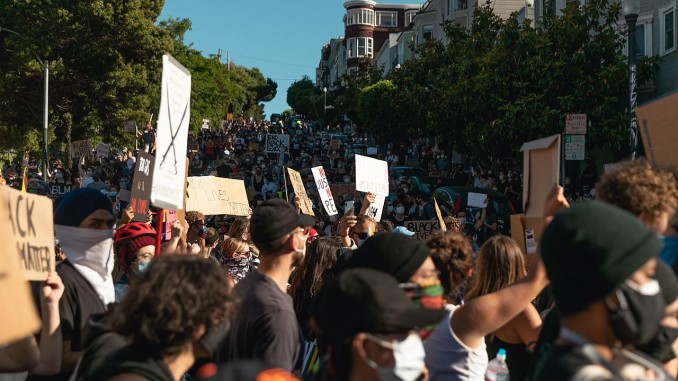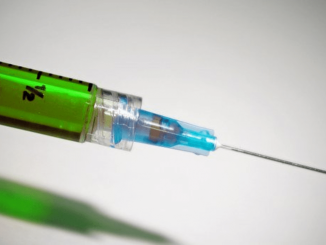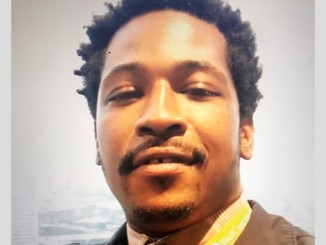
The proclamation that “Black Lives Matter” was first raised in 2013 in protest of the violence against Black people by police and vigilantes. It has since been adopted by a broad movement against racist cop violence and for racial justice generally. That movement exploded again last year in the middle of the pandemic. COVID-19 aggravated the effects of historic racism. The crisis of the virus demonstrated the continuation of racism’s effects in health care access, jobs, income, housing, education and it clearly did not stop the scourge of police violence.
Sadly, George Floyd is not the only Black person who struggled to breathe over the past year. The COVID-19 pandemic has devastated this entire society, taking the lives of over 400,000 people in the U.S. so far, and leaving an unknown number of people with permanent health afflictions from this respiratory illness. But Black people, and people of color more generally, have been hit particularly hard. As of November 2020, Black people were 1.4 times as likely to contract COVID-19, 3.7 times as likely to be hospitalized from the virus and 2.8 times as likely to die from the virus compared to their white counterparts.
Should this pandemic inequality be as a surprise? African Americans have considerably higher rates of chronic illnesses associated with greater vulnerability to COVID-19, such as asthma, diabetes, hypertension, and obesity. Then there is the issue of access to health care. In 2018, Black people were 1.5 times as likely to be uninsured as white people. In addition, around 20 percent of Black people had the option of working from home because of COVID compared to around 30 percent of white people, meaning a higher risk of exposure at work. It is worth noting that despite all of the supposed praises for the workers that were deemed “essential” and expected to continue showing up to work, their average pay was estimated to be $13.48 an hour. In short, in the same way that the virus exacerbates the vulnerabilities associated with preexisting medical conditions, the COVID-19 pandemic has exacerbated the vulnerabilities caused by preexisting racial inequalities.
While many Black people were forced to work in vulnerable “essential work” positions, a disproportionate number also lost their jobs because of the pandemic. For example, a Pew research survey found that 29 percent of Black people reported that they or someone in their household lost their jobs during the pandemic compared to 23% of white people.
This unequal trend is built on top of longstanding pre-existing inequalities. While around 14 percent of children in the United States are Black, they made up more than 26 percent of children living below the poverty line in 2019. Although government unemployment statistics are known for undercounting, Black people have long faced consistently higher levels of unemployment. In 2019, African American college graduates had a higher unemployment rate than whites with only a high school diploma. This lack of job opportunities translates to a lack of income, savings, and wealth. Coming out of the 2008 financial crash, the official unemployment rate of Black people increased to double digits and remained that high for more than six years. For comparison, the official unemployment rate of white people never reached double digits during this same period.
When society was told to “shelter in place” during this pandemic, what did it mean for the rapidly growing population of people who have been struggling to hold on to their shelter because of their dramatic loss of income? It is true that there have been government moratoriums on evictions for a time, but they have not stopped evictions in many cases. Not surprisingly, when these moratoriums have expired, the cases of COVID-19 have shot up. Again, this burden has been felt acutely in the Black population. For example, 22.6 percent of Black renters have reported being behind on their rent compared to 9.6 percent of white renters. In addition, 16.6 percent of Black homeowners reported being behind on their mortgages compared to 6.5 percent of white homeowners.
There is no doubt that online “distance learning” has been a disaster for most working-class families. It has added yet another burden on top of the dire pressures that people face, such as unemployment, cuts to hours, possible evictions and more. For families whose wager-earners continue to go in for work, the scramble to organize childcare has been tough—and this means largely low-income essential workers. Students’ academic development has suffered, and the longstanding inequities of society have been exacerbated. Some researchers have suggested that as many as 42 million Americans do not have access to reliable internet access. It is reported that 35 percent of Black students did not have access to a computer and reliable internet access compared to 19 percent of white students. During the spring of 2020, Los Angeles Unified School District found that 71% of Black high school students participated in online school on an average day compared to 85% of white high school students. The gap in educational opportunities is nothing new in American society, but the pandemic has made it worse.
Finally, the pandemic hasn’t slowed down the violence of the police as seen with the murders of George Floyd, Rayshard Brooks and many others. In 2020, 1,127 people were killed by the police. Of the people that lost their lives, Black people were 28 percent despite making up 13 percent of the total population.
But the violence against people of color at the hands of the police, tragically a routine part of life in America, was once again declared unacceptable by tens of millions of people who took to the streets following the murder of George Floyd. The powerful movement called into question not just the system of policing, but also many of the systems of institutional racism that devalue and destroy Black peoples’ lives.
As we go forward, let’s continue to fight to ensure that Black lives matter in our society. To make “Black Lives Matter” a reality would necessarily mean creating a future where no one’s lives are seen as disposable, where every child has access to the resources necessary to live out their full potential, and no one has to worry about having a roof over their head, access to good food and healthcare, or being shot by a cop because of the color of their skin.




